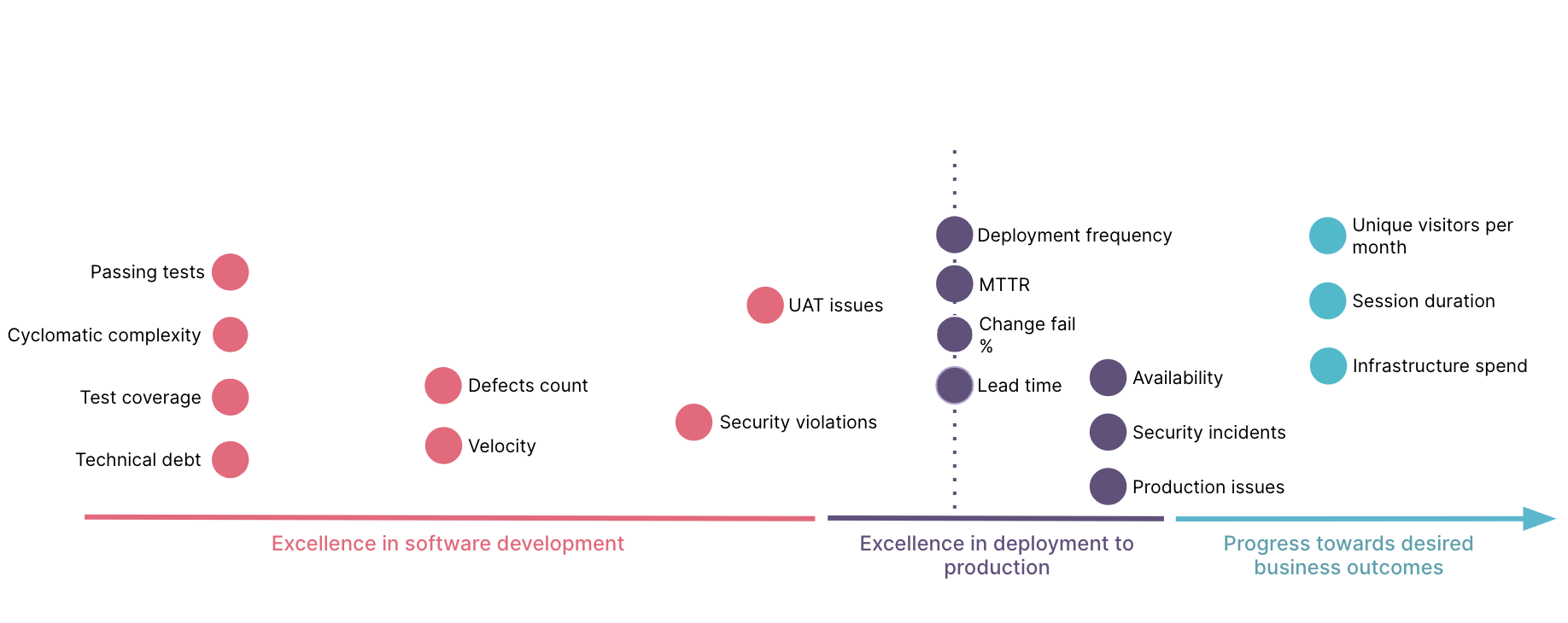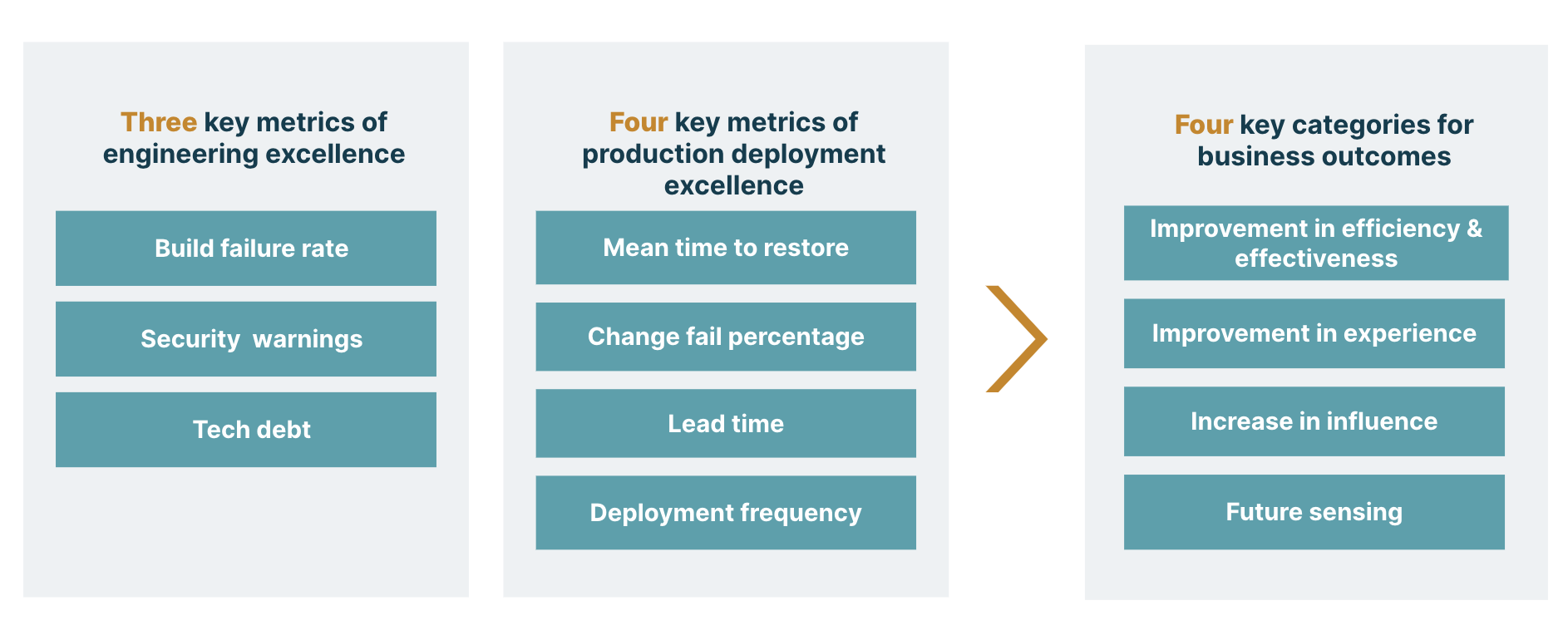The phrase, ‘every business is a tech business’ is commonplace in today’s digital world. This is the case when an organization’s engineering efforts impact business outcomes. However, measuring engineering effectiveness from a business standpoint has continued to be elusive.
This article presents Engineering Excellence to Business Outcomes (EEBO) metrics, which will serve as a framework for tech leadership to measure and demonstrate how every team member contributes to the overall benefit of the organization.
What are EEBO metrics?
EEBO metrics are performance indicators throughout the engineering lifecycle, right from software development to deployment in production. A typical software delivery flow and the landscape of common metrics used, looks like this:


Excellence in software development: These metrics reflect the quality of the software being developed. It includes code quality, test coverage and technical debt
Excellence in deployment to production: These metrics reflect the quality of the deployment process. They include deployment frequency, lead time for changes and mean time to recover
Progress towards desired business outcomes: These include business metrics such as user satisfaction, time to market and revenue growth
We’ve shared some examples of key EEBO metrics below.


Why do organizations need EEBO metrics?
EEBO metrics offer a clear line of sight from engineering excellence to business outcomes. Let’s understand this in a little more detail:
Clear value articulation: EEBO metrics help articulate the value of engineering excellence. They assist in measuring the business impact of engineering efforts, making it easier to communicate its benefits to stakeholders
Guardrails for long-running programs: They also act as fitness metrics for long-running programs. They ensure that engineering excellence is maintained throughout the lifecycle of a project, preventing deviations and derailing
Clarity of purpose: They give each team member clarity on how their work leads to business benefits and how they fit in to the larger picture
How would organizations use EEBO metrics?
Depending on organizational goals, organizations can use EEBO metrics in several ways. We recommend using them for these two primary purposes:
Alerting derailment: EEBO metrics prevent the misalignment of engineering efforts and business outcomes. By monitoring these metrics, organizations can quickly identify problem areas and preemptively take corrective action
Information radiator: By making EEBO metrics visible to all team members, organizations can ensure everyone is informed about progress. This will also encourage collaboration and communication
How not to use EEBO metrics
As with all new frameworks, there is a risk of using them for the wrong purpose. When setting up and using EEBO metrics, we recommend you watch out for the following anti-patterns:
Over-slicing and dicing: As EEBO metrics are outcome-focused, they are useful for measuring overall engineering excellence. They shouldn't, however, be used to analyze specific scenarios or spot bottlenecks. We recommend choosing the appropriate drill-down metrics from the existing multitude of Build and CI/CD tools for such scenarios and complementing them with EEBO metrics in conversations with developers
Growing too large: Often, metrics keep growing to accommodate the representation of teams, departments or leadership. This is adjacent to Conway’s Law, which states that an organization's structure inevitably shapes the way its products and systems are designed. Prevent this eventuality by keeping the EEBO metrics to minimum
How should organizations design good EEBO metrics?
To ensure EEBO metrics aren't susceptible to manipulation, they should have the following characteristics:
Derived or multivariate: You should calculate EEBO metrics from multiple data points or measurements. This will make it harder to manipulate them
Meta in nature: EEBO metrics should be centered on the effectiveness of a process or an output. A narrow focus on a specific area will render them ineffective
Well-understood: Ensure team members are clear about how EEBO metrics are computed in alignment with the vision that the team is working towards. This will make the EEBO metrics relateable and achievable
What are the sensible defaults for EEBO metrics?
To tie engineering excellence to business outcomes, these metrics must originate from the domain or industry in which the organization or product is situated.. Our recommendation is to choose EEBO metrics that are relevant and meaningful to the business. Here are some general guidelines four experience has taught us:
Make success criteria clear: Help teams easily determine if they’ve achieved the goal. While this might seem obvious, it’s surprising how often it’s overlooked. Ensuring this step will help avoid confusion and ensure that everyone is working towards the same objectives
Make the failure threshold clear: Clearly indicate the point at which you need to pivot or terminate. This will ensure the organization takes appropriate action when performance on a metric falls below an acceptable level
Include a remediation plan: Know in advance how to address metrics that are under-performing. Knee-jerk reactions are ineffective and can lead to further issues. Having a well-defined remediation plan will ensure the organization appropriately addresses issues and improves performance
While EEBO metrics help measure engineering excellence and tie them to business outcomes, they can also be a powerful tool for building high-performing teams. They can bring clarity of purpose and provide the necessary guard-rails for team members in the long run. They can help make difficult decisions around pivoting or closing a program. They can also help make these decisions collectively as a team because everyone knows what’s going on and what’s the right thing to do.
Disclaimer: The statements and opinions expressed in this article are those of the author(s) and do not necessarily reflect the positions of Thoughtworks.


















